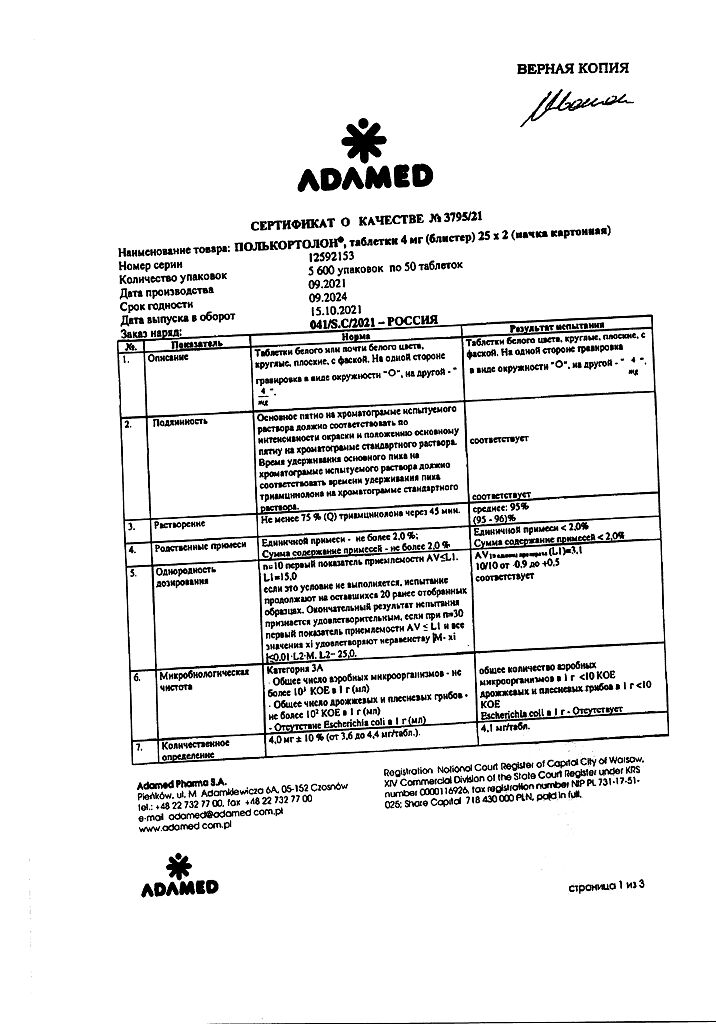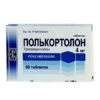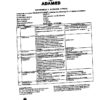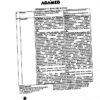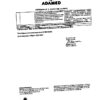No products in the cart.
Polcortolone, tablets 4 mg 50 pcs
€1.00
Out of stock
(E-mail when Stock is available)
Description
Polcortolone is a synthetic glucocorticosteroid, a fluorinated derivative of prednisolone, with strong anti-inflammatory effects. It is thought that 4 mg of triamcinolone has an anti-inflammatory effect equivalent to 4 mg of methylprednisolone, 5 mg of prednisolone, 0.75 mg of dexamethasone, 0.6 mg of betamethasone and 20 mg of hydrocortisone.
It has a weak mineralocorticoid action. Inhibits the development of inflammatory symptoms. Inhibits the accumulation of macrophages, leukocytes and other cells in the inflammatory area. Causes a decrease in capillary permeability. It has immunosuppressive effect; it inhibits cellular immunological reactions.
Inhibits secretion of ACTH by the pituitary gland, which leads to reduced production of glucocorticosteroids and androgens by the adrenal cortex.
It increases protein catabolism, causes an increase in blood glucose concentrations, affects lipid metabolism, increases the concentration of fatty acids in the blood serum. With long-term treatment it is possible to redistribute adipose tissue.
Inhibits bone formation, decreases serum calcium concentration, may cause suppression of bone growth in children and adolescents and development of osteoporosis in patients of all ages.
Indications
Indications
Primary or secondary insufficiency of the adrenal cortex
Congenital adrenal hyperplasia
Subacute thyroiditis
2. Severe allergic diseases that are resistant to other therapies:
Contact dermatitis
Atopic dermatitis
Serum disease
Drug hypersensitivity reactions
Year-round or seasonal allergic rhinitis resistant to other medications
3. Diseases of the musculoskeletal system:
Psoriatic arthritis
Ankylosing spondylitis
Acute and subacute bursitis
/p>
Epicondylitis
Acute tendovaginitis
Posttraumatic osteoarthritis
4. Rheumatic diseases:
Acute rheumatic fever
Rheumatic myocarditis
Rheumatoid arthritis, juvenile rheumatoid arthritis (in cases resistant to other treatments)
Rheumatic polymyalgia, Horton’s disease
5. Systemic connective tissue diseases:
Dermatomyositis
Systemic lupus erythematosus
Mesoarteritis granulomatous gigantocellularis
/p>
Systemic scleroderma
Nodular periarteritis
Recurrent polychondritis
6. Dermatologic diseases:
Exfoliative dermatitis
Herpetiform bullous dermatitis
Severe seborrheic dermatitis
Severe erythema multiforme (Stevens-Johnson syndrome)
/p>
Fungal mycosis
Puberculosis
Severe psoriasis
/p>
Severe eczema
Pemphigoid
7. Hematologic diseases:
acquired autoimmune hemolytic anemia
congenital (erythroid) hypoplastic anemia
anemia due to bone marrow hypoplasia
/p>
secondary thrombocytopenia in adults
idiopathic thrombocytopenic purpura (Verlhof disease) in adults
haemolysis
8. Liver disease:
Alcoholic hepatitis with encephalopathy
Chronic active hepatitis
9. Hypercalcemia in malignancies
10. Cancers:
Leukemia and lymphoma in adults
Acute leukemia in children
11. Neurological diseases:
Tuberculous meningitis with subarachnoid block or at risk of block (in combination with appropriate anti-tuberculosis chemotherapy)
Multiple sclerosis during exacerbation
12. Eye diseases (severe acute and chronic inflammatory processes):
Severe flaccid anterior and posterior uveitis
Optic neuritis
Sympathetic ophthalmia
13. Respiratory diseases:
Bronchial asthma, severe form
Berylliosis
Leffler syndrome, not amenable to therapy by other means
Symptomatic sarcoidosis
./p>
Molten or disseminated pulmonary tuberculosis (in combination with anti-tuberculosis chemotherapy)
Aspiration pneumonitis
14. In organ and tissue transplants – prevention and treatment of graft rejection (in combination with other immunosuppressive drugs).
Active ingredient
Active ingredient
Composition
Composition
One tablet contains:
active ingredient: triamcinolone 4.0 mg
excipients: potato starch – 144.2 mg, magnesium stearate – 1.8 mg, lactose – 200.0 mg.
How to take, the dosage
How to take, the dosage
The dose of Polcortolone is set individually, depending on the indications, the effectiveness of therapy and the patient’s condition. According to the daily rhythm of endogenous glucocorticosteroid secretion, it is recommended to take the drug once a day, in the morning. However, in some cases, more frequent administration of the drug may be necessary. Adults and adolescents over 14 years of age: from 4 to 48 mg/day in one or several doses.
Children: 0.1-0.5 mg/kg body weight per day in one or more doses.
If a dose is missed, take the drug as soon as possible or, if the next dose is approaching, skip the forgotten dose. Do not take a double dose at once.
Polcortolone should be used in the lowest effective dose. If necessary, the dose of the drug should be reduced gradually.
Interaction
Interaction
Heart glycosides: increased risk of cardiac rhythm disturbances and glycoside toxicity associated with hypokalemia.
Barbiturates, antiepileptic drugs (phenytoin, carbamazepine), rifampicin, glutethimide accelerate the metabolism of glucocorticosteroids (by indication of microsomal enzymes), weaken their action.
The antihistamines weaken the effect of triamcinolone.
Amphotericin B, carbohydrase inhibitors: hypokalemia, left ventricular myocardial hypertrophy, circulatory failure.
Paracetamol: hypernatremia, peripheral edema, increased calcium excretion, risk of hypocalcemia and osteoporosis. Increased risk of hepatotoxicity of paracetamol. Anabolic steroids, androgens: increased risk of peripheral edema, acne; use with caution, especially in liver and heart disease.
Estrogen-containing oral contraceptive agents: increase
the concentration of glucocorticosteroid-binding globulins in blood serum, slowed metabolism, increased elimination half-life, increased action of triamcinolone.
Choline-blocking drugs, mainly atropine: increase in intraocular pressure. Anticoagulants (coumarin derivatives, indadione, heparin), streptokinase, urokinase: decreased, and in some patients increased effectiveness; dose should be determined based on prothrombin time; increased risk of ulceration and gastrointestinal bleeding.
Tricyclic antidepressants may exacerbate psychiatric disorders associated with triamcinolone administration. They should not be used to treat these disorders. Oral hypoglycemic drugs, insulin: weakening of hypoglycemic effect, increased blood glucose concentrations; it may be necessary to perform dose adjustment of hypoglycemic drugs.
Antithyroid drugs, thyroid hormones: change in thyroid function; dosage adjustment or discontinuation of antithyroid drug or thyroid hormone may be necessary.
Diuretics: weakening the effect of diuretics (potassium-saving),
hypokalemia.
Laxatives: weakening of action, hypokalemia.
Ephedrine may accelerate glucocorticosteroid metabolism, triamcinolone dose adjustment may be necessary.
Immunosuppressive drugs: increased risk of infection, lymphoma and other lymphoproliferative diseases.
Isoniazid: decreased plasma concentrations of isoniazid, mostly in persons with rapid acetylation; dose modification may be necessary.
Mexiletine: accelerated metabolism of mexiletine and decreased plasma concentrations.
Medications that block neuromuscular conduction (depolarizing myorelaxants): hypocalcemia associated with triamcinolone use may increase synaptic blockade, resulting in increased duration of neuromuscular blockade.
Non-steroidal anti-inflammatory drugs, acetylsalicylic acid, alcohol: weakening of action, increased risk of peptic ulcer disease and bleeding from the gastrointestinal tract.
Drugs and food containing sodium: peripheral edema, arterial hypertension, it may be necessary to limit sodium in the diet and sodium-rich medications; use of glucocorticosteroids sometimes requires additional sodium administration.
Vaccines containing live viruses: while using immunosuppressive doses
glucocorticosteroids may cause viral replication and development of viral disease and decrease antibody production; concomitant use is not recommended.
Other vaccines: increased risk of neurological complications and decreased antibody production.
Folic acid: increased need for this drug.
Special Instructions
Special Instructions
The patient must follow the doctor’s instructions exactly when taking Polcortolone.
Partneral administration of glucocorticosteroids is recommended for patients taking Polcortolone in stressful situations.
Sudden discontinuation of treatment may cause adrenal insufficiency, so the dose of Polcortolone should be reduced gradually.
Polcortolone may mask symptoms of infection and reduce resistance to infection and the ability to localize it.
Long-term use of Polcortolone increases the risk of secondary fungal or viral infections.
Long-term use of Polcortolone may cause the development of cataracts, glaucoma with possible damage to the optic nerves.
Patients taking Polcortolone should not be vaccinated with live virus vaccines. Injection of inactivated viral or bacterial vaccine may not produce the expected increase in antibodies. In addition, patients taking glucocorticosteroids have an increased risk of neurological complications during vaccination.
If Polcortolone is suddenly withdrawn, especially after long-term use, a so-called withdrawal syndrome may develop, manifested by anorexia, elevated body temperature, muscle and joint pain, and general weakness. These symptoms may appear even when there is no insufficiency of the adrenal cortex. In patients with hypothyroidism or liver cirrhosis the effect of triamcinolone is increased.
Mental disorders such as euphoria, insomnia, rapid mood changes, personality changes, severe depression, symptoms of psychosis may appear during the use of Polcortolone. Pre-existing emotional instability or psychotic tendencies may intensify during treatment.
When treating patients with hypoprothrombinemia, triamcinolone and acetylsalicylic acid should be used with caution.
In long-term treatment of children, their growth and development should be monitored.
Special precautions when disposing of unused medication
Medications should not be thrown down drains or into household waste containers. Ask your pharmacist about how to dispose of unused medication. These measures will help protect the environment.
Polcortolone does not normally affect mental responses. However, it can cause dizziness, headache and even mental disorders.
Contraindications
Contraindications
Hypersensitivity to triamcinolone or other components of the drug.
Children under 3 years of age (for this dosage form).
Diseases of the gastrointestinal tract: Esophagitis, gastritis, non-specific ulcerative colitis with threat of perforation or abscessing, diverticulitis, gastric and duodenal ulcer, acute or latent peptic ulcer, newly created intestinal anastomosis;
In diseases of the cardiovascular system, including recent myocardial infarction (patients with acute and subacute myocardial infarction may spread the focus of necrosis, delay the formation of scar tissue and thereby rupture the heart muscle), decompensated chronic heart failure, hypertension, hyperlipidemia;
Endocrine diseases: Diabetes mellitus (including impaired carbohydrate tolerance), thyrotoxicosis, hypothyroidism, Icenko-Cushing’s disease;
Severe chronic renal and/or hepatic failure, nephrourolithiasis; Hypoalbuminemia and conditions predisposing to its occurrence;
Systemic osteoporosis, myasthenia gravis, acute psychosis, obesity (III-IV stage.), poliomyelitis (except for bulbar encephalitis), open- and closed-angle glaucoma, pregnancy, lactation.
Side effects
Side effects
The frequency and severity of side effects depend on the duration of use, the amount of dose used, and the ability to follow the circadian rhythm of administration.
In short-term use of Polcortolone, like other glucocorticosteroids, side effects are rare. The following side effects are possible when using Polcortolone for a long time:
Endocrine system side effects:
Secondary adrenal and hypothalamic-pituitary insufficiency (especially during stressful situations such as illness, trauma, surgery); Icenko-Cushing’s syndrome (moon-shaped face, pituitary-type obesity, hirsutism, increased blood pressure, dysmenorrhea, amenorrhea, myasthenia grafts), delayed sexual development and growth suppression in children, menstrual disorders, reduced glucose tolerance, manifestation of latent diabetes and increased need for insulin or oral hypoglycemic agents in diabetic patients, hirsutism.
Digestive system disorders:
“Steroid” gastric and 12 duodenal ulcer with possible perforation and bleeding, pancreatitis, flatulence, erosive esophagitis, digestive disorders, nausea, vomiting, increased or decreased appetite, hiccups. In rare cases – increased activity of “liver” transaminases and alkaline phosphatase.
The cardiovascular system:
Arrhythmias, bradycardia (up to cardiac arrest); development (in predisposed patients) or increased severity of chronic heart failure, ECG changes characteristic of hypokalemia, arterial hypertension, hypercoagulation, thrombosis. In patients with acute and subacute myocardial infarction – expansion of the focus of necrosis, delayed formation of scar tissue, which may lead to rupture of the heart muscle.
Nervous system disorders:
Delirium, disorientation, euphoria, hallucinations, manic-depressive -psychosis, depression, paranoia, increased intracranial pressure with congestive optic nipple syndrome (pseudotumor of the brain – most often in children, usually after reducing the dose too quickly; symptoms-headache, impaired visual acuity or double vision); vertigo, pseudotumor cerebri, seizures, dizziness, headache, nervousness or restlessness, sleep disturbances.
Sensory organs:
Posterior subcapsular catarrh, increased intraocular pressure with possible damage to the optic nerve, glaucoma, exophthalmos, tendency to develop secondary bacterial, fungal or viral eye infections, trophic corneal changes.
Metabolic disorders:
. Negative nitrogen balance due to protein catabolism, hyperglycemia, glucosuria, increased Ca2+ excretion, hypocalcemia, weight gain, increased sweating, sodium and fluid retention in the body (peripheral edema), hypernatremia, hypokalemic syndrome (hypokalemia, arrhythmia, myalgia or muscle spasm, unusual weakness and fatigue).
Musculoskeletal disorders:
. Slow growth and ossification processes in children (premature closure of epiphyseal growth zones), osteoporosis (very rare – pathological bone fractures, spinal compression fracture, aseptic necrosis of the head of the humerus and femur, pathological fractures of long tubular bones), muscle tendon rupture, muscle weakness, “steroid” myopathy, decrease in muscle mass (atrophy).
Skin and mucous membranes:
Steroid acne, stretch marks, delayed wound healing, skin thinning, petechiae, ecchymosis, hematoma, tendency to develop pyoderma and candidiasis.
Allergic reactions: skin rash, itching, anaphylactic shock.
Other:
The development and exacerbation of infections (the appearance of this side effect is promoted by co-administration of immunosuppressants and vaccination), leukocyturia, “withdrawal” syndrome.
Overdose
Overdose
Pregnancy use
Pregnancy use
Similarities
Similarities
Additional information
| Shelf life | 3 years |
|---|---|
| Conditions of storage | In a dry, light-protected place at a temperature not exceeding 25 °C |
| Manufacturer | Polfa Warsaw Pharmaceutical Plant, Poland |
| Medication form | pills |
| Brand | Polfa Warsaw Pharmaceutical Plant |
Related products
Buy Polcortolone, tablets 4 mg 50 pcs with delivery to USA, UK, Europe and over 120 other countries.


